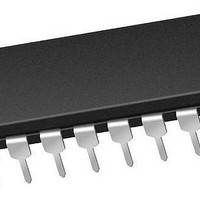PIC16F1829-E/P Microchip Technology, PIC16F1829-E/P Datasheet - Page 63

PIC16F1829-E/P
Manufacturer Part Number
PIC16F1829-E/P
Description
14 KB Flash, 1K Bytes RAM, 32 MHz Int. Osc, 18 I/0, Enhanced Mid Range Core 20 P
Manufacturer
Microchip Technology
Series
PIC® XLP™ mTouch™ 16Fr
Datasheet
1.PIC16LF1829-ISO.pdf
(420 pages)
Specifications of PIC16F1829-E/P
Core Processor
PIC
Core Size
8-Bit
Speed
32MHz
Connectivity
I²C, LIN, SPI, UART/USART
Peripherals
Brown-out Detect/Reset, POR, PWM, WDT
Number Of I /o
17
Program Memory Size
14KB (8K x 14)
Program Memory Type
FLASH
Eeprom Size
256 x 8
Ram Size
1K x 8
Voltage - Supply (vcc/vdd)
1.8 V ~ 5.5 V
Data Converters
A/D 12x10b
Oscillator Type
Internal
Operating Temperature
-40°C ~ 125°C
Package / Case
*
Processor Series
PIC16F182x
Core
PIC
Data Bus Width
8 bit
Data Ram Size
1 KB
Interface Type
I2C, SPI, USART
Maximum Clock Frequency
32 MHz
Number Of Programmable I/os
18
Number Of Timers
5
Operating Supply Voltage
1.8 V to 5.5 V
Maximum Operating Temperature
+ 125 C
Mounting Style
Through Hole
Lead Free Status / RoHS Status
Lead free / RoHS Compliant
Lead Free Status / RoHS Status
Lead free / RoHS Compliant
- Current page: 63 of 420
- Download datasheet (5Mb)
5.2.2.3
The 500 kHz internal oscillator is factory calibrated.
This internal oscillator can be adjusted in software by
writing to the OSCTUNE register
the HFINTOSC and MFINTOSC clock sources are
derived from the 500 kHz internal oscillator a change in
the OSCTUNE register value will apply to both.
The default value of the OSCTUNE register is ‘0’. The
value is a 6-bit two’s complement number. A value of
1Fh will provide an adjustment to the maximum
frequency. A value of 20h will provide an adjustment to
the minimum frequency.
When the OSCTUNE register is modified, the oscillator
frequency will begin shifting to the new frequency. Code
execution continues during this shift. There is no
indication that the shift has occurred.
OSCTUNE does not affect the LFINTOSC frequency.
Operation of features that depend on the LFINTOSC
clock source frequency, such as the Power-up Timer
(PWRT), Watchdog Timer (WDT), Fail-Safe Clock
Monitor (FSCM) and peripherals, are not affected by the
change in frequency.
5.2.2.4
The Low-Frequency Internal Oscillator (LFINTOSC) is
an uncalibrated 31 kHz internal clock source.
The output of the LFINTOSC connects to a postscaler
and multiplexer (see
software, using the IRCF<3:0> bits of the OSCCON
register. See
Clock Switch Timing”
LFINTOSC is also the frequency for the Power-up Timer
(PWRT), Watchdog Timer (WDT) and Fail-Safe Clock
Monitor (FSCM).
The LFINTOSC is enabled by selecting 31 kHz
(IRCF<3:0> bits of the OSCCON register = 000) as the
system clock source (SCS bits of the OSCCON
register = 1x), or when any of the following are
enabled:
• Configure the IRCF<3:0> bits of the OSCCON
• FOSC<2:0> = 100, or
• Set the System Clock Source (SCS) bits of the
Peripherals that use the LFINTOSC are:
• Power-up Timer (PWRT)
• Watchdog Timer (WDT)
• Fail-Safe Clock Monitor (FSCM)
The Low Frequency Internal Oscillator Ready bit
(LFIOFR) of the OSCSTAT register indicates when the
LFINTOSC is running and can be utilized.
2010 Microchip Technology Inc.
register for the desired LF frequency, and
OSCCON register to ‘1x’
Internal Oscillator Frequency
Adjustment
LFINTOSC
Section 5.2.2.7 “Internal Oscillator
Figure
for more information. The
5-1). Select 31 kHz, via
(Register
5-3). Since
Preliminary
5.2.2.5
The system clock speed can be selected via software
using the Internal Oscillator Frequency Select bits
IRCF<3:0> of the OSCCON register.
The output of the 16 MHz HFINTOSC and 31 kHz
LFINTOSC connects to a postscaler and multiplexer
(see
Select bits IRCF<3:0> of the OSCCON register select
the frequency output of the internal oscillators. One of
the following frequencies can be selected via software:
• 32 MHz (requires 4X PLL)
• 16 MHz
• 8 MHz
• 4 MHz
• 2 MHz
• 1 MHz
• 500 kHz (Default after Reset)
• 250 kHz
• 125 kHz
• 62.5 kHz
• 31.25 kHz
• 31 kHz (LFINTOSC)
The IRCF<3:0> bits of the OSCCON register allow
duplicate selections for some frequencies. These dupli-
cate choices can offer system design trade-offs. Lower
power consumption can be obtained when changing
oscillator sources for a given frequency. Faster transi-
tion times can be obtained between frequency changes
that use the same oscillator source.
PIC16F/LF1825/1829
Note:
Figure
Following any Reset, the IRCF<3:0> bits
of the OSCCON register are set to ‘0111’
and the frequency selection is set to
500 kHz. The user can modify the IRCF
bits to select a different frequency.
5-1). The Internal Oscillator Frequency
Internal Oscillator Frequency
Selection
DS41440A-page 63
Related parts for PIC16F1829-E/P
Image
Part Number
Description
Manufacturer
Datasheet
Request
R

Part Number:
Description:
IC, 8BIT MCU, PIC16F, 32MHZ, SOIC-18
Manufacturer:
Microchip Technology
Datasheet:

Part Number:
Description:
IC, 8BIT MCU, PIC16F, 32MHZ, SSOP-20
Manufacturer:
Microchip Technology
Datasheet:

Part Number:
Description:
IC, 8BIT MCU, PIC16F, 32MHZ, DIP-18
Manufacturer:
Microchip Technology
Datasheet:

Part Number:
Description:
IC, 8BIT MCU, PIC16F, 32MHZ, QFN-28
Manufacturer:
Microchip Technology
Datasheet:

Part Number:
Description:
IC, 8BIT MCU, PIC16F, 32MHZ, QFN-28
Manufacturer:
Microchip Technology
Datasheet:

Part Number:
Description:
IC, 8BIT MCU, PIC16F, 32MHZ, QFN-28
Manufacturer:
Microchip Technology
Datasheet:

Part Number:
Description:
IC, 8BIT MCU, PIC16F, 32MHZ, SSOP-20
Manufacturer:
Microchip Technology
Datasheet:

Part Number:
Description:
IC, 8BIT MCU, PIC16F, 20MHZ, DIP-40
Manufacturer:
Microchip Technology
Datasheet:

Part Number:
Description:
IC, 8BIT MCU, PIC16F, 32MHZ, QFN-28
Manufacturer:
Microchip Technology
Datasheet:

Part Number:
Description:
IC, 8BIT MCU, PIC16F, 20MHZ, MQFP-44
Manufacturer:
Microchip Technology
Datasheet:

Part Number:
Description:
IC, 8BIT MCU, PIC16F, 20MHZ, QFN-20
Manufacturer:
Microchip Technology
Datasheet:

Part Number:
Description:
IC, 8BIT MCU, PIC16F, 32MHZ, QFN-28
Manufacturer:
Microchip Technology
Datasheet:

Part Number:
Description:
MCU 14KB FLASH 768B RAM 64-TQFP
Manufacturer:
Microchip Technology
Datasheet:

Part Number:
Description:
7 KB Flash, 384 Bytes RAM, 32 MHz Int. Osc, 16 I/0, Enhanced Mid Range Core, Low
Manufacturer:
Microchip Technology

Part Number:
Description:
14KB Flash, 512B RAM, 256B EEPROM, LCD, 1.8-5.5V 40 UQFN 5x5x0.5mm TUBE
Manufacturer:
Microchip Technology
Datasheet:










